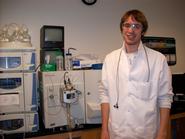
Following pregnancy, women sometimes have a high concentration of what is known as alpha-fetoprotein, a protein found in blood plasma and produced in the yolk sac and liver during the fetal stage of development. Previous studies have shown that the alpha-fetoprotein has pronounced affects against breast cancer, and therefore women who have had multiple births might be less at risk. This summer Nathaniel Taylor ’11 looked at two sub-derivatives (small pieces) of alpha-fetoprotein, Peptides TPVNP and STPNVP to see if the properties they possess could be extracted for pharmaceutical purposes. He worked on the research with Silas D. Childs Professor of Chemistry Robin Kinnel.
The most fundamental part of his research is changing both peptides into a circular structure. By making it cyclical, it becomes more stable and more effective for the pharmaceutical methods they hope to carry out. The key is to set up the peptide so the ends are close together; the way chemists arrange substances is called stereochemistry, and in this respect, it plays a role in how easily the peptide is molded into a circular form.
To change their structure, Taylor has tried a handful of different techniques. One is called ring-closing metathesis, which requires bonding two double bonds and is meant for only seven- or eight-membered rings. He also has tried using a method called direct lactonization. So far, the former has given him more success.
Taylor is double major in chemistry and mathematics, and says that there are many advantages to implementing a mathematical frame of mind when doing chemistry research.
“Just as you do proofs in math, in chemistry you use a logical flow of reasoning,” he said. “You have to go through your knowledge base to get from one reaction to another.”
He has almost equal interests in chemistry and math, so picking just one might be difficult. Nevertheless, Taylor knows he wants to go to graduate school for one of them. This year he will take part in the Budapest Semesters in Mathematics program through St. Olaf College in Minnesota. When he is living on campus, he is exercises the other side of his brain through musical activities like Choir, Duelly Noted (an a cappella group), worship band for the Christian Fellowship, and Gospel Choir.
Taylor is a graduate of Stroudsburg High School.
The most fundamental part of his research is changing both peptides into a circular structure. By making it cyclical, it becomes more stable and more effective for the pharmaceutical methods they hope to carry out. The key is to set up the peptide so the ends are close together; the way chemists arrange substances is called stereochemistry, and in this respect, it plays a role in how easily the peptide is molded into a circular form.
To change their structure, Taylor has tried a handful of different techniques. One is called ring-closing metathesis, which requires bonding two double bonds and is meant for only seven- or eight-membered rings. He also has tried using a method called direct lactonization. So far, the former has given him more success.
Taylor is double major in chemistry and mathematics, and says that there are many advantages to implementing a mathematical frame of mind when doing chemistry research.
“Just as you do proofs in math, in chemistry you use a logical flow of reasoning,” he said. “You have to go through your knowledge base to get from one reaction to another.”
He has almost equal interests in chemistry and math, so picking just one might be difficult. Nevertheless, Taylor knows he wants to go to graduate school for one of them. This year he will take part in the Budapest Semesters in Mathematics program through St. Olaf College in Minnesota. When he is living on campus, he is exercises the other side of his brain through musical activities like Choir, Duelly Noted (an a cappella group), worship band for the Christian Fellowship, and Gospel Choir.
Taylor is a graduate of Stroudsburg High School.
